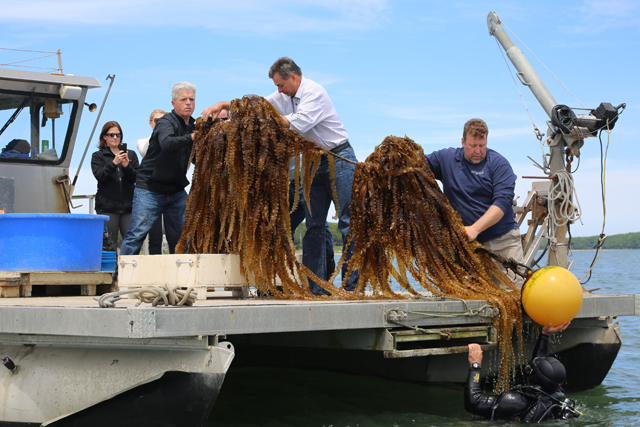First kelp crop harvested in Cornell pilot program

Early Thursday afternoon, Suffolk County Executive Steve Bellone and Suffolk County Legislator Al Krupski climbed aboard a barge and headed into the Peconic Bay. Their mission: to harvest sugar kelp, a type of seaweed.
The officials participated in the first harvest of Cornell Cooperative Extension Marine Program’s pilot Peconic Estuary Seaweed Aquaculture Feasibility Study, which is funded in part through Suffolk County.
It is designed to assess the feasibility of a commercial kelp business on Long Island, as well as to eliminate copious amounts of nitrogen in local bodies of water, including both Peconic and Gardiners bays, something Mr. Bellone said would have “a really positive impact on our bays and waterways.”
“It’s important for a lot of reasons,” Kim Manzo, Cornell Cooperative Extension marine program educator, said of the pilot program. “It’s a win-win because it’s pulling nitrogen out of the water, which is a main problem in our estuaries. And it’s a win-win because it’s a commodity for local baymen to jump on and utilize.”
The five lines used for the pilot study were moved from Orient, where they’ve been growing since December, earlier this week, Ms. Manzo said. On Thursday, the third line was pulled in Long Island Sound near Connecticut.
A cold water species, sugar kelp typically grows from November to May. But this year’s weather forced those at Cornell to plant their lines in December and harvest them in May, said Steve Schott, the study’s project manager who’s also a marine botany/habitat restoration specialist with the Cornell.
In addition to funding a portion of the project, the county administers the underwater leasing program for commercial shellfish growing. The county is going to allow five, one-acre sites on existing leased land to grow sugar kelp, Mr. Krupski said, adding that because kelp is grown in the winter there isn’t conflict with the shellfish industry.
“The pilot that Cornell did is important because if you are a leaseholder and you put out your gear in a place and it was an area that wasn’t gonna grow or you put it too deep or something, it would be pretty disappointing,” Mr. Krupski said. “The scientists are going to tell the best areas of the bay where you’re going to have success growing it commercially and the water depth.”
After being pulled from the water the kelp was immediately wrapped in burlap. This helps preserve the moisture in the plant so it doesn’t dry out and shrink, which is important since the Cornell team has to measure the length and harvest numerous 20-centimeter long sections to the lab for analysis, Ms. Manzo said.
Kelp naturally grows horizontally but Cornell is growing its lines vertically as a way to test the feasibility of different depths, and therefore different bodies of water, are for growing sugar kelp, she said.
“I’m very impressed with what they’ve done so far,” Mr. Krupski said. “It takes a lot of experience and skill to set the gear and maintain the gear. It’s not simple.”
Photo credit: Nicole Smith




 ‘
‘







